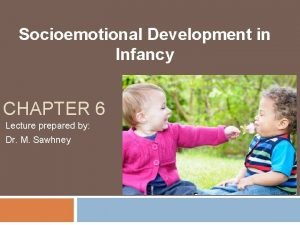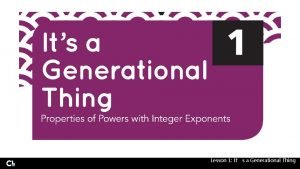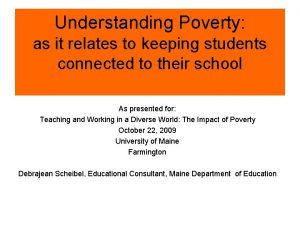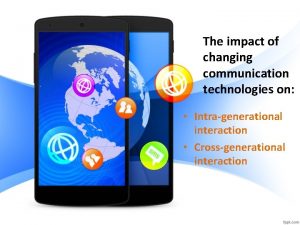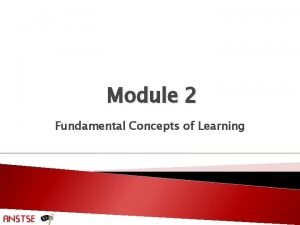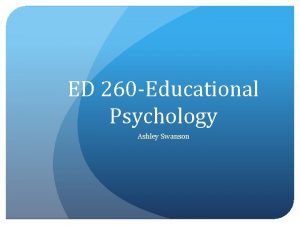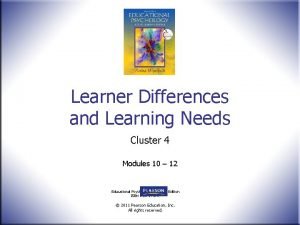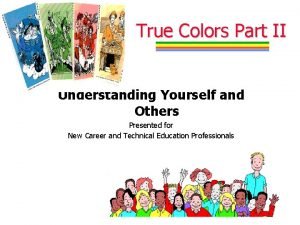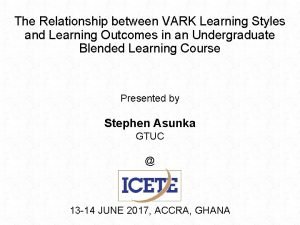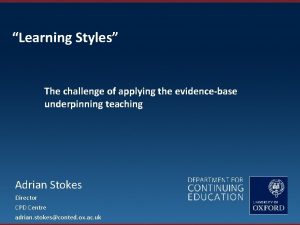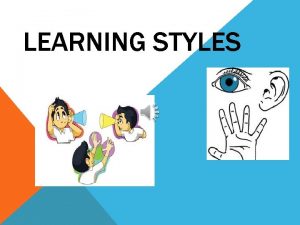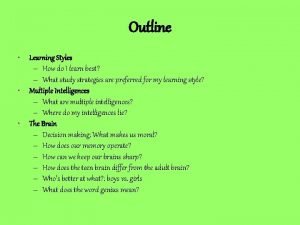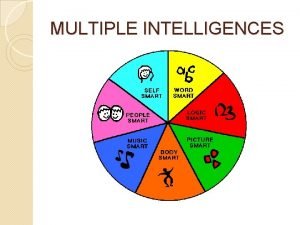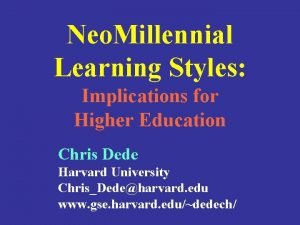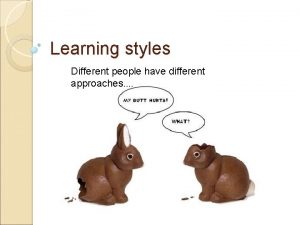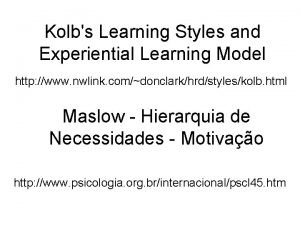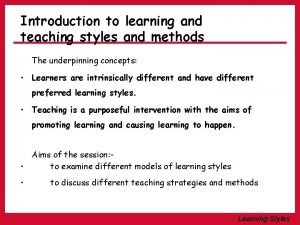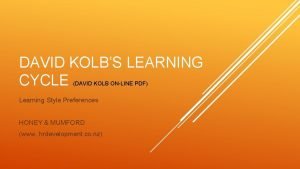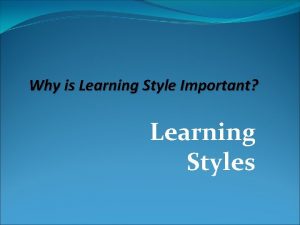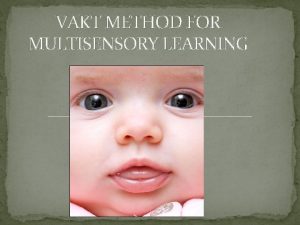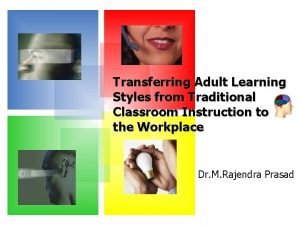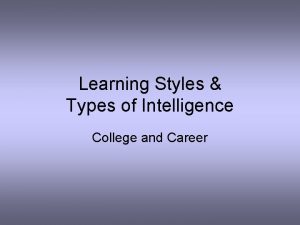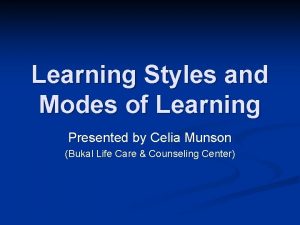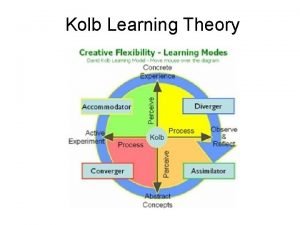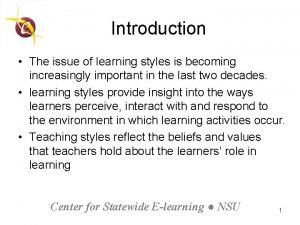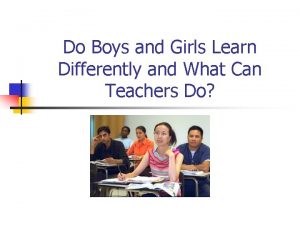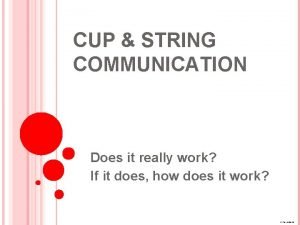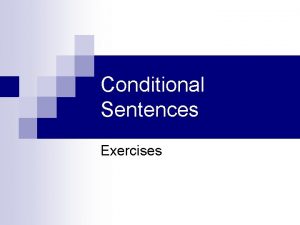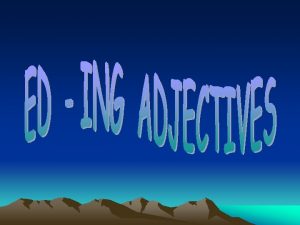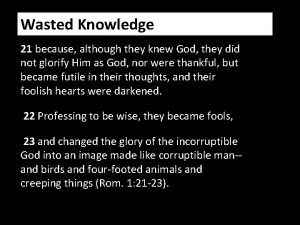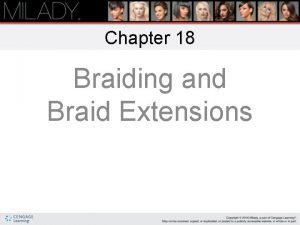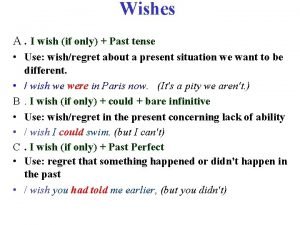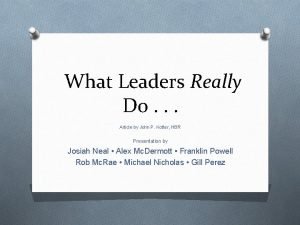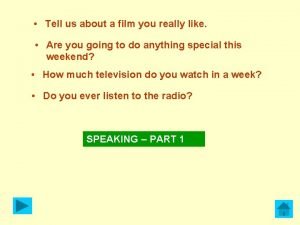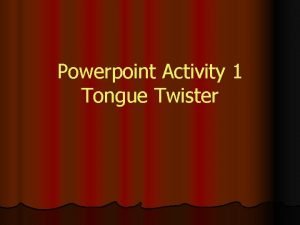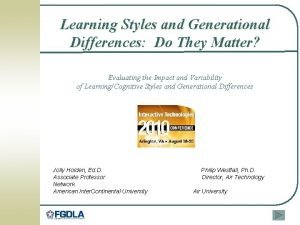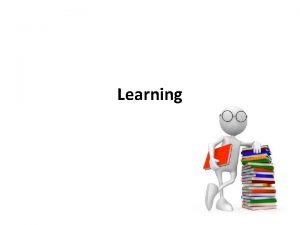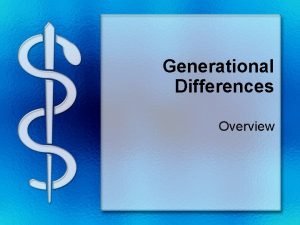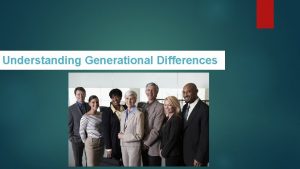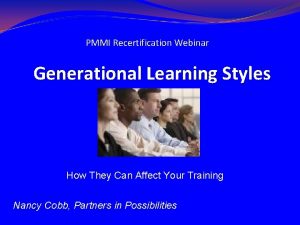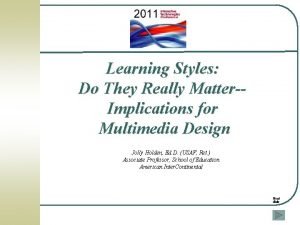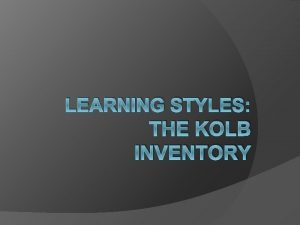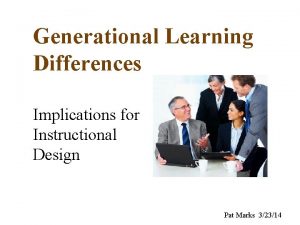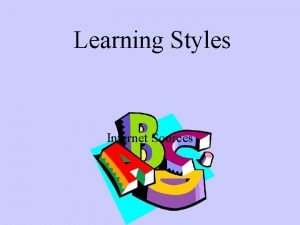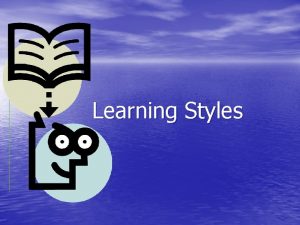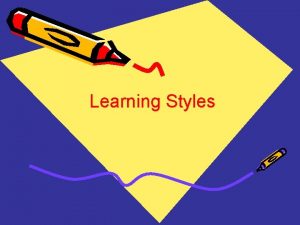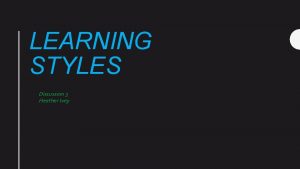Learning Styles and Generational Differences Do They Really




























































- Slides: 60

Learning Styles and Generational Differences: Do They Really Matter? Jolly Holden, Ed. D. (USAF, Ret. ) Associate Professor American Inter. Continental University Philip Westfall, Ph. D. (USAF, Ret) Director, Air Technology Network Air University Download presentation: http: //www. fgdla. us/e-learning_summit. html? r=20110018140622 Next slide

So What…Why Are You Here? At a recent national training conference, some of the preconference workshops and sessions stated you will… • • • Identify learning styles Accommodate different learning styles Discover your learning style However, there is no discussion concerning what they are, their effects, how many there are, and do they really affect learning? Consequently, in this session, you will get the unbiased answers to the above questions because… You are Entering the “No Spin Zone” Prior slide Next slide

Goals of This Webinar l Inform--What are learning styles, cognitive styles, learning modalities, and generational differences l l Educate--What does the research indicate? Enlighten—So what? Why so much confusion? What can instructors/trainers do to facilitate the transfer of learning? Prior slide Next slide

Presentation Menu (Click any of the hyperlinks to go directly to that topic) l What are Learning/Cognitive Styles? • • What are Learning Modalities? What’s the Difference? Review of the Research What Does it All Mean? l Generational Differences l Learning /Cognitive Style Resources • What About Generational Differences? • Focusing on Generational Differences • Myths and the Digital Generation • Beyond the Hype—What Does it All Mean? Prior Return Next slide to Menu slide

So What? • • • A recent article (Dec, 2009) in the Chronicle of Higher Education entitled Matching Teaching Style to Learning Style May Not Help Students, challenged the prevailing concept of learning styles and their affect on student performance. The investigators found “no evidence…for validating the educational applications of learning styles into general educational practice. ” and concluded “the instructional method that proves most effective for students with one learning style is not the most effective method for students with a different learning style. ” This is not surprising…these results and conclusions have been supported repeatedly in the research for the past 30 years. Prior Return Next slide to Menu slide

So What? • • • This is not a new debate but a continuing investigation into the efficacy of learning styles that has spanned 60 years. To that end, there is a strong intuitive appeal to the notion there are individual preferences and styles of learning. That said, we’re not going to solve the problem today, but… at the end of this presentation, you will better understand: The concept of learning styles and assess their variability and impact on learning Prior Return Next slide to Menu slide

Why the Confusion? Ask Google Let’s explore some Google results. First, it is important to distinguish between learning styles and cognitive styles…they are not the same (we’ll discuss the “what” later). AND “learning styles” “cognitive styles” Search terms “learning styles” “cognitive styles” “learning styles ” + “cognitive styles” “learning styles” Results 1, 900, 000 201, 000 28, 700 “learning styles ” -“cognitive styles” 1, 670, 000 “cognitive styles” -“learning styles” 177, 000 NOT “cognitive styles” Question: How can one possibly sift thru 1. 9 M hits and find the useful information? Answer: You can, but you don’t have the time for that…so we did it for you. Prior Return Next slide to Menu slide

What are Learning Styles? l l Basically, learning styles refers to the concept that individuals differ in regard as to what specific mode in acquiring information is most effective for them. However, many educational psychologists believe learning styles are a myth…that while individual differences in learning exists, they are a result of acquired/innate preferences but do not affect learning anymore than the truck delivering groceries at your local store affects your dietary habits. Blaming learning styles as to why some students do not learn is a convenient scapegoat for poor instruction Dr. David Merrill, esteemed educational psychologist Prior Return Next slide to Menu slide

What are Learning Styles? l Most often learning styles are characterized and categorized by how information is preferentially perceived (sensory or intuitive), organized (inductive or deductive), processed (active or reflective), and modality preference (visual, aural, or kinesthetic). • • • The most commonly used model of learning styles are the visual, aural, and kinesthetic (VAK) models. The VAK model is perhaps the most misunderstood and over emphasized reason as to why some students do not learn The VAK test reliability and validity scores are so low that any results and/or conclusions derived from them are suspect (more on this latter) Prior Return Next slide to Menu slide

What are Cognitive Styles? l l Cognitive styles are viewed as a bipolar dimension representing a person's typical or habitual mode of problem solving, thinking, perceiving and remembering; are considered stable over time, and related to theoretical or academic research. Cognitive styles primarily focus on cognition and how information is processed in the brain. So…what’s the difference? A learning style or modality describes how information enters the brain: visually, aurally, or tactilely, whereas cognitive style refers to how the information is processed once the information gets to the brain. Prior Return Next slide to Menu slide

What are Learning Modalities? l l l Learning, or perceptual modalities, are sensory based and refer to the primary way our bodies take in information though our senses: visual (seeing), auditory (hearing), kinesthetic (moving), and tactile (touching). Humans are multi-sensory in that the brain can perform several activities at once when processing information (e. g. , tasting and smelling, hearing and seeing). While the brain processes wholes and part simultaneously, learning engages the whole body Note: Multi-sensory processing is not the same as multi-tasking (partial tasking) in that the brain is not very good at multi-tasking, per se, attempting to perform multiple tasks simultaneously. Prior Return Next slide to Menu slide

What’s the Difference? • • • Not surprisingly, there is substantial confusion between learning styles and learning modalities where the terms are often used interchangeably. One of the reasons is the complexity of how the human brain functions as it relates to one’s modalities in receiving information (visual, aural, kinesthetic) and how the brain processes that information (cognition). Continued research into neuroscience is discovering how the brain processes information acquired through our primary learning modalities: visual, aural, and tactile. Note: Neuroscience has estimated 85% of the human brain is wired to process visual information, and that 90% of what the brain processes is visual information, so one’s primary learning modality is visual. Prior Return Next slide to Menu slide

What’s the Difference? • • • An important finding from that research is that memory is usually stored independent of any modality. You typically store memories in terms of meaning—not in terms of whether you saw (visual), heard (aural), or physically (tactile/kinesthetic) interacted with the information. To that end, our brain is constantly searching its memory for context based on prior knowledge/experience. • Note: In the absence of visual cues, our brains create “mental pictures” based upon our schema to add context to what is printed/spoken. Click here for an example. The so what: retention is improved through words and pictures (visual media) rather than through words alone. Prior Return Next slide to Menu slide

What Does the Research Reveal About Learning Styles? • • • Simply stated, the research has not revealed a compelling argument as to the impact of learning styles and their effect on predicting learning outcomes. Postulates learning/cognitive styles have <5% effect on the variability in learning. The majority of research does not support a significant statistical relationship between learning/cognitive styles and learning outcomes. Based on several decades of empirical evidence, matching learning activities/ strategies with specific learning styles does not often result in improved learning. Dr. Allan Jeong, Associate Professor, Dept. of Educational Psychology and Learning Systems, Florida State University Prior Return Next slide to Menu slide

What Does the Research Reveal About Learning Styles? • • • Small sample sizes, flawed sampling methodology, and nonexperimental research designs casts doubt on the results of VAK learning style research. Low validity and reliability scores of the VAK instruments used to identify specific learning styles raise serious doubts about their psychometric properties. In other words, if the tests used to identify learning styles are not reliable or valid, then any conclusions or results based upon them are suspect. Prior Return Next slide to Menu slide

What Does the Research Reveal About Learning Styles? • • • These tests are not controlled in their distribution and/or reproduction, or administered under controlled conditions. Scores on the VAK learning style tests vary greatly among same individual. VAK test questions focus on out-of-context preferences which allows for wide range of interpretations. Intervening variables confound the results. For examples of the many different VAK learning styles test, click these external links: -- VAK test 1 -- VAK test 2 Prior Return Next slide to Menu slide

What Does the Research Reveal About Cognitive Styles? • • The research pertaining to cognitive styles is quite different than learning styles in that the reliability and the validity of the instruments used to identify them are much more robust. The most researched cognitive style is Herman Witkin’s Field Dependence/Field Independence. • • The test used to identify Field Dependence (FD) and Field Independence (FI) is the Embedded Figures Test Highly reliable and valid (Cronbach Alpha >80% ) Prior Return Next slide to Menu slide

Characteristics of Field Dependent and Field Independent Learns • Field dependent learner… • Field independent learner… • • • Processes information globally Holistic approach to problem solving Views the perceptual field as a whole Socially oriented Uses spectator approach for concept attainment Relies on external cues to guide their behavior • • • Highly analytical Relies on internal cues (gravity and vestibular) to guide their behavior Breaks the field down into its component parts Not influenced by the existing structure Impersonal orientation Uses hypothesis-testing approach to attain concepts Prior Return Next slide to Menu slide

What Does the Research Reveal About Cognitive Styles? • Results of Field Independent (FI) and Field Dependent (FD) cognitive styles reveal: • • • FI attracted to engineering, hard sciences, mathematics, computer sciences/engineering FI able to extrapolate detailed information from complex figures FI correlated in predicting success in engineering courses FI less influenced by visual effects in media No difference in learning outcomes based on instructional media Prior Return Next slide to Menu slide

Given the Research, Why all the Confusion? • It’ s not surprising the reference to learning styles is one of the most misunderstood and overused issues confronting educational and training communities. • • • Part of the reason is the wide disparity in the definition of learning styles and their relationship to cognitive styles. Furthermore, there is continued debate as to whether learning styles even exist, with the only current evidence of their existence being the tests used to identify them. Confusion is further exacerbated in that the research has identified over 71 different types of learning styles (Table 1), summarized into the 13 most influential models (Table 2), and families (Table 3) Prior Return Next slide to Menu slide

So What Does it all Mean? l l Since neuroscience has revealed 90% of what the brain processes is visual information, one’s primary learning modality is visual. Therefore, compliment text-based presentations and lectures with visual components/aids. • • This adds context to the written/spoken word Provides a structure for learning when a task cannot be completed through a series of steps Note: Research has indicated prior knowledge and intrinsic motivation account for ~70% of the variability in learning. Prior Return Next slide to Menu slide

So What Does it all Mean? l l Cognitive science has revealed learners differ in their abilities with different modalities, but teaching to a learner’s best modality doesn't affect learning outcomes. What does matter is whether the learner is taught in the content's best modality…people learn more when content drives the choice of modality. Different ways of knowing and understanding demand different ways of designing and delivering instruction Consider adapting learning environments and/or designing instruction to accommodate a diverse learning population by integrating cognitive learning strategies. For more on cognitive learning strategies and knowledge construction, click here Prior Return Next slide to Menu slide

Conclusion l l Do learning styles exist…read the research and decide for yourself. Do learning styles affect performance and/or learning outcomes…overwhelming body of research says no. l l l To many variables affect performance. Attempting to isolate variables requires a robust multivariate experimental design. Intervening /confounding variables that cannot be identified may affect performance. Prior Return Next slide to Menu slide

Conclusion l If you want conduct research on learning/cognitive styles… l l Ensure the tests used to identify them are reliable and valid. Use an experimental research design. Use valid sampling methodology. Clearly define your independent (effect) variable. Prior Return Next slide to Menu slide

Generational Differences Philip Westfall, Ph. D. Director, Air Technology Network Air University Department of the Air Force Prior Return Next slide to Menu slide

What About Generational Differences? Should generational membership be considered when designing and delivering instruction? Prior Return Next slide to Menu slide

What About Generational Differences? l Chronicle of Higher Education’s The Millennial Muddle (Oct. 2009) • • “The brightest bunch of do-gooders in modern history” or “selfinvolved knuckleheads”? “To accept generational thinking, one must find a way to swallow two large assumptions. That tens of millions of people, born over about 20 years, are fundamentally different from people of other age groups—and that those tens of millions of people are similar to each other in meaningful ways. ” Palmer H. Muntz, Director of admissions Lincoln Christian University Prior Return Next slide to Menu slide

What About Generational Differences? l Cooperative Institutional Research Program at UCLA show small, gradual changes; differences are not significant between generations but only over multiple generations. Annual surveys since 1966. American Freshman: Forty Years of Trends Prior Return Next slide to Menu slide

Focusing on Generational Differences • Chronicle of Higher Education’s Generational Myth report of research on literacy and technology, Sept 2008: • • “Today’s young people—including college students—are just more complicated than any analysis of imaginary generations can ever reveal. ” Must consider vast range of skills, knowledge & experience of many segments of society—avoid focusing more on needs of socially or financially privileged and overestimate the digital skills of young people in general Prior Return Next slide to Menu slide

Focusing on Generational Differences l l Familiarity with, understanding of, and dexterity with technology varies greatly within the 18 -23 age group a few with amazing skills, a large number who can’t deal with computers. Keep in mind that in any large social grouping of people —by geography, ethnicity, generation, etc. —there is far greater variability on measures of attitudes & aptitudes within a group than there is between groups Prior Return Next slide to Menu slide

Focusing on Generational Differences Chronicle of Higher Education’s Generational Myth report continues: l Thinking in generations too simplistic—keeps us from examining ethnic, gender, and class distinctions too closely. l “Once we assume that all young people love certain forms of interaction and hate others, we forge policies and design systems and devices that match those predispositions. By doing so, we either pander to some marketing cliché or force otherwise diverse group of potential users into a one size-fitsall system that might not meet their needs. ” Prior Return Next slide to Menu slide

Myths and the Digital Generation Myth: “The kids will take to e-learning like ducks to water” Reality l “Not quite. . . students do want to be connected, but principally to one another; they want to be entertained, principally by games, music, and movies. . E-learning at its best is seen as a convenience and at its worst as a distraction. ” Thwarted Innovation What Happened to e-learning and Why by Robert Zemsky and William F. Massy 2004 by The Learning Alliance at the University of Pennsylvania Prior Return Next slide to Menu slide

Myths and the Digital Generation Myth: “The Digital Generation is far more adept at learning through technology” Reality: l Greatest disappointment of our time: Huge investments made in technology (beginning with Telecommunications Act of 1996) in public schools with negative results. l Leisure-time tech skills don’t translate to educational & training use of technology. l Fast scanning doesn’t translate into academic reading. l Reading proficiency dropped from 40% to 35% from 1992 to 2005. Prior Return Next slide to Menu slide

Myths and the Digital Generation l Intellectual habits such as deep reflection decrease with increase time spent on browsing, blogging, IMing, Twittering, and Facebook Online Literacy Is a Lesser Kind, Mark Bauerlein, Chronicle of Higher Education, Sep. , 2008 Prior Return Next slide to Menu slide

Myths and the Digital Generation Myth: “The Digital Natives lead the way in exploiting the new social media” Reality: Recent study asked information workers of all ages in US, UK, France, Germany, & Australia about business communication habits: l Gen X—and not Gen Y—make up the majority of those who use social networking for business, followed closely by Boomers age 55 and older. l Gen Y is least likely to share information via text message (26% compared to 47% of those age 55 -plus), and least likely to use video conferencing, video chat, and Web conferencing tools. Prior Return Next slide to Menu slide

Myths and the Digital Generation l l Gen Y uses social networking the least frequently (40% of Gen Y workers who use social media for business do so daily, compared to 50% of those age 55 -plus). Older Boomers (age 55 -plus) have increased their business use of social media 79% in the last year. Gen Y Social Networking Technology Surprise, Citrix Systems, Inc, Tech Talk, Feb 11, 2011 Prior Return Next slide to Menu slide

Myths and the Digital Generation Myth: “Research conclusively shows that learning abilities and styles of the Digital Natives are significantly different than those of previous generations” Reality: A comprehensive literature review in 2006 conducted by Professor Thomas Reeves , Univ. of Georgia: Do Generational Differences Matter in Instructional Design? • Research on generational differences suffers from many same weaknesses found in learning styles research—throws grave doubt on validity of using learning styles as basis for accommodating students of any generation. Prior Return Next slide to Menu slide

Myths and the Digital Generation “A large group of university researchers has launched a campaign to refute claims that generational differences in the workplace are huge and pervasive. For example, researchers from the University of Kentucky and Kutztown University argue: Much prior generational research is based on samples limited to college-bound adolescents, college students, or white-collar workers… As such, claims of generational differences have been limited by sample selection and other factors, leaving broad judgments about entire generations open to skepticism and criticism (Real, Mitnick, and Maloney, 2010). Prior Return Next slide to Menu slide

Myths and the Digital Generation “Researchers at the University of Western Ontario, Michigan State University, and the University of California, Davis, argue against major generational differences in the workplace, citing sample limitations, failure to replicate findings in a national sample, and issues with the measures and instruments in studies that found broad generational differences (Trzesniewski, Donnellan, and Robins, 2008 a). Put simply, the generational stereotypes perpetuated in popculture media, misguided organizational training, and lunchroom conversations have very little basis in fact. ” Age-Based Stereotypes: Silent Killer of Collaboration and Productivity by Chris Blauth, Jack Mc. Daniel, Craig Perrin, Paul B. Perrin, Ph. D. Published by Achieve Global Prior Return Next slide to Menu slide

Beyond the Hype— What Does It All Mean? Student performance is not based in a significant way on: þ Learning style þ Generational membership þ Technology Prior Return Next slide to Menu slide

Beyond the Hype— What Does the Research Reveal? So what are the most significant learner variables? The two most significant factors that have significant predictive validity: l Prior knowledge (ability/self-regulation) • • l l SAT scores r=0. 64 USAFA Pla. Val predictive validity r=0. 67 Motivation (intrinsic value/self-efficacy) • Journal of Ed Psy (APA), r=0. 32 -0. 36 The rest is noise-level Note: r = Pearson’s Product Moment Correlation Prior Return Next slide to Menu slide

Beyond the Hype— Conclusion l Instead of worrying about whether Boomers, Gen. Xers or Millennials will learn more from direct instruction or virtual reality games…[one] should begin by identifying the needs of any given set of learners, design the best possible prototype learning environments in situ. The Millennial Muddle” by E. Hoover, Chronicle of Higher Education, Oct 2009 Prior Return Next slide to Menu slide

The End Prior Return slide to Menu

Describing and “Seeing” the Constellation Orion • The constellations are totally imaginary things that have been made up over • Return to main presentation • • • the past 6, 000 years. So how would you describe something imaginary to your students? You may begin by describing the three bright stars in a row that form Orion’s belt and the other stars that form his sword. But your students have trouble “visualizing” how the stars shape the figure of Orion. To assist them in creating a mental picture, you show them a star chart of Orion to help them “visualize” this imaginary figure. But they still can’t quite get it, so to further enhance their mental image, you show them another detailed chart depicting Orion. The aha moment…they got it because they now can “see” Orion, so they conclude they must be visual learners. But…are they really visual learners or did you create the visual image for them by adding context to the description?

Orion Star Chart Return to prior slide

Orion Figure Outlined in a Star Chart Return to prior slide

The Constellation Orion Return to prior slide

Intentionally Left Blank Click this button to return to the prior slide

Table 1: Types of Learning/Cognitive Styles Return to main presentation convergers vs. divergers verbalisers vs. imagers holists vs. serialists deep vs. surface learning activists vs. reflectors pragmatists vs. theorists adaptors vs. innovators assimilators vs. explorers field dependent vs. field independent globalists vs. analysts assimilators vs. accommodators imaginative vs. analytic learners intuitionists vs. analysts extroverts vs. introverts seeing vs. hearing sensing vs. intuition thinking vs. feeling non-committers vs. plungers common-sense vs. dynamic learners concrete vs. abstract learners random vs. sequential learners initiators vs. reasoners judging vs. perceiving left brainers vs. right brainers meaning-directed vs. undirected theorists vs. humanitarians activists vs. theorists pragmatists vs. reflectors organizers vs. innovators analytics/inductives/successiv e processors vs. globals/deductivess/simultane ous processors executive, hierarchic, conservative vs. legislative, anarchic, liberal

Table 2: Most Influential Models of Learning/Cognitive Styles Return to main presentation Allinson and Hayes’ Cognitive Styles Index (CSI) Apter’s Motivational Style Profile (MSP) Dunn and Dunn model and instruments of learning styles Entwistle’s Approaches and Study Skills Inventory for Students (ASSIST) Gregorc’s Mind Styles Model and Style Delineator (GSD) Herrmann’s Brain Dominance Instrument (HBDI) Honey and Mumford’s Learning Styles Questionnaire (LSQ) Jackson’s Learning Styles Profiler (LSP) Kolb’s Learning Style Inventory (LSI) Myers-Briggs Type Indicator (MBTI) Riding’s Cognitive Styles Analysis (CSA) Sternberg’s Thinking Styles Inventory (TSI) Vermunt’s Inventory of Learning Styles (ILS)

Table 3: Families of Learning/Cognitive Styles Learning styles are largely sensory based Return to main presentation Betts (1909) Betts Inventory Bartlett (1932) Gordon (1949) Scale of Imagery Control Scheehan (1967) Shortened Betts Inventory Paivio (1971) Individual Difference Questionnaire (IDQ) Marks (1973) Marks Vividness of Visual Imagery Questionnaire Dunn and Dunn (1975, 1979, 1992, 2003) VAK Learning Style Theory; Learning Style Inventory(LSI); Building Excellence Survey (BES) Torrance (1990) Style of Learning and Thinking Riding (1991) Cognitive Style Analysis (CSA) Learning styles reflect deepseated cognitive structure Guilford (1950) Convergent/divergent thinking Prettigrew (1958) Scale of Cognitive Style Gardner et al. (1959) Tolerant/ intolerant Broverman (1960) Kagen (1967) Matching Familiar Figures Test Messick (1976) Analytic / non-analytic conceptualizing Hunt (1978) Paragraph Completion Method Cooper (1997) Learning Styles ID Weinstein, Zimmerman, Palmer (1988) Learning and Study Strategies Inventory Learning styles reflect relatively stable personality type Witkin (1962) Group Embedded Figure Test (GEFT) Myers – Briggs (1962) Myers-Briggs Type Indicator (MBTI) Apter (1998) Motivation Style Profile (MSP) Epstein-Meier (1989) Constructive Thinking Inventory (CTI) Miller (1991) Personality typology: cognitive, affective, conative Harrison- Branson (1998) revised Inquiry Mode Questionnaire Jackson (2002) Learning Style Profiles (LSP) Learning styles are flexibly stable learning preferences Kolb (1976, 1985, 1999) Learning Style Inventory (LSI); Revised Learning Style Inventory (R-LSI); LSI Version 3 Schmeck (1977) Inventory of Learning Processes Honey and Mumford (1982) Learning Style Questionnaire (LSQ) Felder and Silverman (1989) Index of Learning Styles (ILS) Kaufmann (1989) The A-E Inventory Allinson and Hayes (1996) Cognitive Style Index (CSI) Herrmann (1995) Brain Dominance Instrument (BDI)

Resources l l l Coffield, F. , Moseley, D. , Hall, E. , & Ecclestone, K. (2004). Should we be using learning styles: What research has to say to practice. Learning Skills and Research Centre, London. Retrieved from http: //www. ttrb. ac. uk/attachments/c 455 e 462 -95 c 44 b 0 d-8308 -bbc 5 ed 1053 a 7. pdf Cognitive/Learning Styles (n. d. ). Theory Into Practice, Retrieved from http: //tip. psychology. org/styles. html Cronbach, L. (1975). Beyond the Two Disciplines of Scientific Psychology. "American Psychologist, " 116 -127. Cronbach, L. & Snow, R. (1977). Aptitudes and Instructional Methods: A Handbook for Research on Interactions. New York: Irvington Publishers. Curry, L. (1990). A critique of research on learning styles. Educational Leadership, 56(2), 50 -56. De. Ture, M. (2004). Cognitive Style and Self-Efficacy: Predicting Success in Online Education. The American Journal of Distance Education, 18(1), 21 -38 Return Next to Menu slide

Resources l l Dumbo, Myron H. , & Howard, K. (2007). Advice about the Use of Learning Styles: A Major Myth in Education. Journal of College Reading and Learning, v 37 n 2 p 101 -109 Spr 2007. Retrieved from: http: //www. eric. ed. gov/ERICWeb. Portal/search/detailmini. jsp? _nfpb=true&_&ERI CExt. Search_Search. Value_0=EJ 767768&ERICExt. Search_Search. Type_0=no& accno=EJ 767768 Howles, S. (n. d. ). Learning styles: What the Research Says and How to Apply it to Designing E-Learning. Session TH 101, University of Wisconsin-Madison. Retrieved from http: //isg. urv. es/library/papers/learning%20 styles_overview. pdf Learning Orientation Research: Individual Differences in Learning (2004). Retrieved from http: //www. trainingplace. com/source/research/cronbach. htm Learning styles and pedagogy in post-16 learning: A systematic and critical review. (2008). Learning and Skills Research Centre, Department for Education and Skills, UK (2004). Retrieved from http: //www. hull. ac. uk/php/edskas/learning%20 styles. pdf Prior Return Next slide to Menu slide

Resources l l Mayer R. E. & Moreno R. (2003) Nine ways to reduce cognitive load in multimedia learning. In Web-Based Learning: What Do We Know? Where Do We Go? (eds R. Bruning, C. A. Horn & L. M. Pytlik. Zillig), pp. 23– 44. Information Age Publishing, Greenwich, CT. Matching Teaching Style to Learning Style May Not Help Student. (Dec 15, 2009). Chronicle of Higher Education. Retrieved from http: //chronicle. com/article/Matching-Teaching-Style-to/49497/ Multimodal Learning Through Media: What the Research Says. (2008). Metiri Group--Commissioned by Cisco. Retrieved from http: //www. cisco. com/web/strategy/docs/education/Multimodal-Learning. Through-Media. pdf Pashler, H. , Mc. Daniel, M. , Rohrer, D. , & Bjork, R. (2008). Learning Styles: Concepts and Evidence, Psychological Science in the Public Interest, Retrieved from http: //www. psychologicalscience. org/journals/pspi/PSPI_9_3. pdf Prior Return Next slide to Menu slide

Resources l l l Sharp, J. G. , Byrne, J. , & Bowker, R. (2008). The Trouble with VAK. Educational Futures Vol. 1(1) August 2008. Retrieved from http: //www. educationstudies. org. uk/materials/sharp_et_al_2. pdf Snow, R. (1980). Aptitude Processes. In R. Snow, P. Frederico, & W. Montague (eds. ), Aptitude, Learning and Instruction, Conative and Affective Process Analyses (Vol. 1, pp. 27 -60). Hillsdale, NJ: Erlbaum Associates. Snow, R. (1989). Aptitude-Treatment Interaction as a framework on individual differences in learning. In P. Ackermann, R. J. Sternberg, & R. Glaser (eds. ), Learning and Individual Differences. New York: W. H. Freeman. Stahl, Steven A. (1999). Different Strokes for Different Folks: A Critique of Learning Styles. The American Educator, Fall, 1999. Willingham, D. (2005). Do Visual, Auditory, and Kinesthetic Learners Need Visual, Auditory, and Kinesthetic Instruction? American Educator, Summer 2005 Prior Return slide to Menu

What are Cognitive Learning Strategies? l Cognitive learning strategies are methods used to help learners link new information to prior knowledge in facilitating the transfer of learning through the systematic design of instruction • • Focuses on how the learner processes the knowledge Provides a structure for learning when a task cannot be completed through a series of steps (scaffolding) Supports the learner as s/he develops internal procedures that enable him/her to perform tasks that are complex, and can increase the efficiency with which the learner approaches a learning task. Tailoring instruction for different levels of prior knowledge

What are Cognitive Learning Strategies? • • • Learning these strategies are aided by their incorporation into instruction. The utility of cognitive learning strategies can be employed by faculty to facilitate the activation and retention of prior knowledge by focusing on knowledge construction. Knowledge construction is a methodological approach that assumes knowledge needs to be constructed – – Involves the opportunity to critically analyze information, dialogue with others about its meaning, reflect how the information fits within one’s belief and value systems (schema), and arrive at a meaningful understanding of that information In this process, information becomes transformed into knowledge

What is Schema? • • The contents of long term memory are sophisticated structures that permit us to perceive, think, and solve problems, rather than a group of rote learned facts. These structures are known as schemas (a mental framework for understanding and remembering information) and permit us to treat multiple elements as a single element. Schemas are the cognitive structures that make up our knowledge base and assist us in knowledge construction. Schemas can be “activated” through the use of cognitive learning strategies

• • • What is Schema Activation? Schema activation refers to an array of activities designed to activate relevant knowledge in students’ memory prior to encountering new, to be learned information. Schema activation is the process of engaging prior knowledge, which is organized in the brain in schemata. Schema activation is an important scaffolding tool where learning depends upon the activation of old knowledge to provide an appropriate schema into which new knowledge can be incorporated. Schema Activation Prior knowledge: Schema activation engages prior knowledge New knowledge: Schema activation links prior knowledge to new knowledge Comprehension: Schema activation creates connections which increase comprehension

Group Embedded Figures Test Example (GEFT)
 What generation is 1984 babies
What generation is 1984 babies High context vs low context culture ppt
High context vs low context culture ppt Summary of an inspector calls
Summary of an inspector calls This country is known for its unique vocals
This country is known for its unique vocals Thomas and chess temperament
Thomas and chess temperament Lesson 1 it's a generational thing m5-23 answers
Lesson 1 it's a generational thing m5-23 answers Generational poverty
Generational poverty St vinny
St vinny Intra-generational interaction
Intra-generational interaction 10 up
10 up 7 learning styles and vark similarities
7 learning styles and vark similarities Three types of learning
Three types of learning Learning styles and multiple intelligences
Learning styles and multiple intelligences Learner differences and learning needs
Learner differences and learning needs Cuadro comparativo entre e-learning b-learning y m-learning
Cuadro comparativo entre e-learning b-learning y m-learning Gold orange blue green personality test
Gold orange blue green personality test Vark learning styles fleming 1987
Vark learning styles fleming 1987 Educationplanner learning style
Educationplanner learning style Objectives of learning styles
Objectives of learning styles Outline learning styles
Outline learning styles Multiple intelligences
Multiple intelligences Kinesthetic learning style
Kinesthetic learning style Neo millennial
Neo millennial Objectives of learning styles
Objectives of learning styles Kolbs learning styles
Kolbs learning styles Driving communication style
Driving communication style Why is knowing your learning style important
Why is knowing your learning style important Socioculturalism
Socioculturalism Kolbs learning styles
Kolbs learning styles Conclusion of learning styles
Conclusion of learning styles Vakt learning styles
Vakt learning styles Adult learning styles
Adult learning styles Tactile learner careers
Tactile learner careers Education styles
Education styles Kolb learning styles
Kolb learning styles Conclusion of learning styles
Conclusion of learning styles Male vs female learning styles
Male vs female learning styles Vark a guide to learning styles
Vark a guide to learning styles Rankings: what are they and do they matter?
Rankings: what are they and do they matter? Individual differences factors
Individual differences factors Basic human aspirations
Basic human aspirations Does the cup and string work
Does the cup and string work And the tree was happy but not really
And the tree was happy but not really If we'd seen you we (stop)
If we'd seen you we (stop) They seek him here they seek him there
They seek him here they seek him there You are not rejected
You are not rejected Jordan 14
Jordan 14 Grammar rules frustrate me they're not logical they are so
Grammar rules frustrate me they're not logical they are so For they not know what they do
For they not know what they do Knowledge not shared is wasted
Knowledge not shared is wasted Explain the use of the square paddle brush in braiding
Explain the use of the square paddle brush in braiding Removing room service equipment description
Removing room service equipment description Only past tense
Only past tense Scientific notation is a shorthand way of writing really
Scientific notation is a shorthand way of writing really What leaders really do hbr
What leaders really do hbr What can you tell us about the film
What can you tell us about the film Scientific notation shorthand
Scientific notation shorthand Tosses his guts back into his body
Tosses his guts back into his body Tongue twister
Tongue twister It really burned me up when you yelled at me.
It really burned me up when you yelled at me. A marketer can really satisfy everyone in the
A marketer can really satisfy everyone in the




